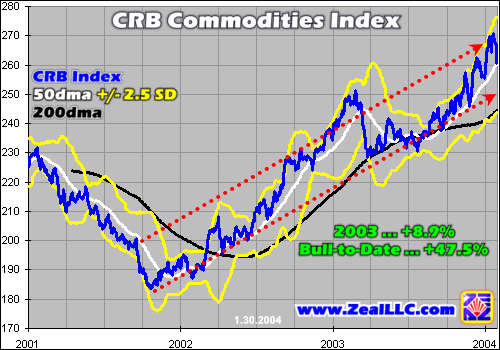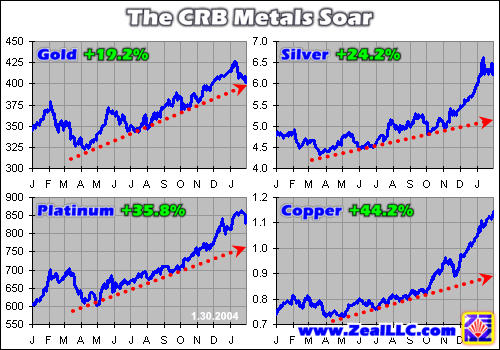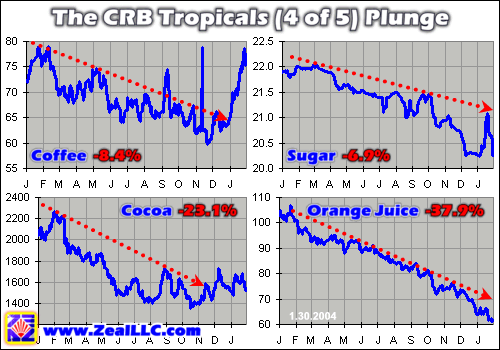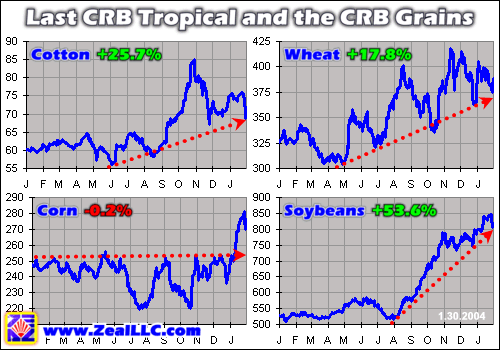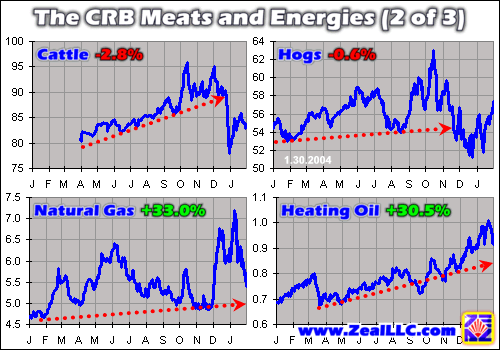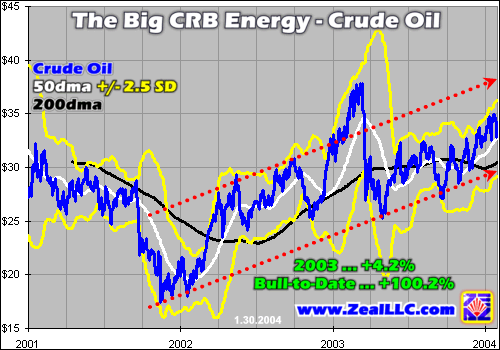|
|
|||||||
|
|
|
|
|
|
|
|
|
|
Great Commodities Bull 2 Adam Hamilton February 6, 2004 4919 Words
Seemingly eons ago in April 2001, I penned an essay called “The Great Commodities Bull of the 00’s”. Its thesis, as you can certainly guess from its title, was the notion that commodities in general would enter a Great Bull market in this decade, creating vast wealth for the prudent contrarian investors deploying their capital into the commodities arena early.
While that was almost three years ago, amazingly I still receive lots of inquiries on that dusty old commodities-bull essay! In fact it may be one of my most popular weekly essays out of hundreds in terms of the number of sequel requests that I have received to continue this line of financial research. I am not the only one fascinated by the awesome prospect of a new Great Bull in commodities!
With the benefit of almost several more years of market data, not to mention priceless experience watching and trading the markets as events unfold in real-time, a follow-up essay is certainly overdue. We have reached a point in time where the original Great Commodities Bull of the 00’s thesis can be checked against real hard data to see if it has withstood the challenging test of time.
Why another 1970s-style Great Commodities Bull this decade? I am not going to rehash my entire first essay here, which discussed this in considerable depth, but the general reasons are still very important to understand. There are extremely powerful cyclical, psychological, fundamental, economic, geopolitical, and inflation arguments underlying this important thesis.
From a cyclical perspective, the financial markets move in great waves throughout history. This is easiest to understand in the common stock-market terms with which we are all familiar. Once every third of a century or so, a Long Valuation Wave cycle runs through the stock markets. First stocks are generally undervalued and loathed, but over the following decade or two they eventually soar and are loved to crazy overvaluations. Valuations oscillate in perpetual bust-to-boom-to-bust cycles, all throughout history.
Commodities work the same way as stocks, also running in great cycles running about a third of a century each as well. There are times when commodities boom to stellar new highs, such as in the 1970s, and there are other times when their bottoms fall out in gut-wrenching busts, as in the late 1990s. Not coincidentally, commodity waves tend to be out of phase with the equity waves, meaning that a commodity boom is most likely around an equity bust and vice versa. Tangible and intangible assets are seldom both fashionable at the same moment in history!
During the massive stock-market superbull of the late 1990s, one of the worst commodity busts in history was occurring. The extraordinarily important first graph in my original essay of long-term real commodities prices clearly outlines the abysmal depths of this particular commodities bust. In inflation-adjusted real terms, commodities prices hit their lowest levels in at least 80 years in the late 1990s! It was a horrific bust indeed.
As every contrarian instinctively knows, it is out of this very belly of dark despair at long-term bust bottoms where the seeds of a glorious brand-new boom are sown. Only several years ago investors had the magnificent opportunity to buy commodities near century lows in real terms, the ultimate Buy Low proposition! The cyclical nature of commodities is an important foundation for the Great Commodities Bull of the 00’s.
Naturally market psychology also plays heavily into these great commodities cycles that run a third of a century or so each. During big commodity booms, such as in the late 1970s, commodities are as hot and popular as Internet stocks were in the late 1990s. Greed abounds and everyday average investors scramble over themselves to buy into the skyrocketing commodities realm. If you were an investor during the late 1970s, you know exactly what I mean!
Conversely during the brutal commodities busts, everyone hates commodities with a passion. Back in 2001, when commodities were bottoming and I penned my original essay, people treated you like a financial leper if you were bullish on commodities. They ridiculed you by saying that commodities were cheap and abundant, that their prices had been plunging for decades, that they were so old-fashioned, etc. Man I received a lot of flak for that essay!
But as contrarians, we want to buy when everyone else hates an investment and it is so out of favor that the mere mention of it draws heaps of ire and revulsion. The second foundation for the Great Commodities Bull of the 00’s is the incredible depth of negativity surrounding its long-term bottom in late 2001. I can think of no other major asset class at that time that was so universally loathed. To this day, if you mention commodities investing at a cocktail party you will probably still get laughed at.
Fundamentally, this psychological loathing near bust bottoms creates huge structural problems. When everyone hates an investment class, it cannot capture the necessary capital to grow and expand. With commodities in general viewed as useless ancient relics during the go-go 1990s, commodity-producing infrastructure decayed around the world. Who wanted to invest billions of dollars in “boring” assets like oil refineries that might return 15% a year when the Internet stocks were rocketing up by hundreds of percents a year?
The net result was a choking off of commodities capacity. Prices of commodities plunged to such abysmal depths that it just wasn’t profitable to invest in producing them. Over time this created our present situation today, where commodities demand is booming but the capacity just isn’t there yet to supply this increased demand. The best example of this is natural gas in the US. In the late 1990s it was so cheap that everyone thought it was free, but demand was soaring and infrastructure still cannot keep up, so its price keeps on rising.
In contrast, remember the massive oversupply in fiber-optic cabling laid around the world in the late 1990s? Everyone loved the New Era promises of unlimited wealth so investors poured all their attention and capital into high-tech ventures. Ultimately so much fiber was planted that the vast majority of it remains dark, or unused, to this day around the world. While the 1990s tech bubble voraciously sucked in almost all capital like a financial black hole, commodities infrastructure was starved nearly to death in a capital famine.
The capital-investment famine in commodities in the 1990s helped create the enormous commodities-investment opportunities today. Commodities demand is growing all the time, but supplies are generally low since big money hasn’t poured into producing commodities since the 1980s. This creates a perfect economic foundation for the Great Commodities Bull of the 00’s. When you witness rising demand chasing a supply that is low or growing slowly, the only possible free-market solution is rising prices.
And where is this demand coming from? Worldwide, which is where the geopolitical foundations for the Great Commodities Bull are found. Even our modern high-tech world relies heavily on tangible physical commodities, from the silicon in our computer chips to the steel in our cars to the lumber in our homes to the oil that gets all this stuff delivered to us, commodities are a crucial component of our lives today. And, not surprisingly, people around the world are striving for American levels of comfort and consumption, which will ultimately vastly increase commodities demand.
Think of China and India, for example. China is the world’s leading exporter and is developing an enormous manufacturing base unequalled in world history. The Chinese people are slowly growing more prosperous over time and are starting to demand more commodities, everything from oil to transport goods to food to lumber to increase their standard of living. With over a billion Chinese striving for American standards of per-capita commodity consumption, this current Great Commodities Bull ought to dwarf any other in history!
And India has another billion people of its own, with the same hopes and dreams as the Chinese or American people to create better lives for themselves and increase the standard of living for their children. The Indians are training the best engineers and scientists in the world today, and their stellar standards of education make American public schools look like illiterate day-care playgrounds. As the Indians start to earn and consume like Americans, their demand for commodities will be insatiable as well.
If you can imagine over two billion Asians seeking to live and enjoy the abundances of life like we Americans do today, and we are less than one-seventh of this number, it is not hard to understand why we are almost certainly in the earliest stages of a breathtaking commodities superbull!
That is not all though! Governments around the world insist on repeating the same deadly mistakes as their predecessors by making worthless paper into legal-tender currencies, under threat of force. Governments love this paper at first, as it allows them to create new “money” out of thin air at will so they can grow and spend and enslave their people without restraint. Even many falsely-so-called “conservatives” today have been hoodwinked into believing that governments and their fiat-currency inflation schemes are good, a terrible folly that history universally teaches is ultimately disastrous.
As the governments relentlessly inflate their paper supplies, relatively more money chases after relatively fewer goods, including commodities, and the nominal prices of commodities rise as inflation devalues major global currencies. Rampant fiat-currency inflation, and the disastrous negative real rates that it spawns, was one of the primary drivers of the Great Bull in commodities in the 1970s, and it is back with a vengeance today.
Did the fundamental case for the Great Commodities Bull of the 00’s withstand the test of time since 2001? It remains rock solid friends!
Cyclically we are emerging from a brutal bust and multi-decade commodities bottom in late 2001, with nowhere to go but up. Psychologically there was no major investment class more hated than commodities only a few years ago, a contrarian’s dream. Fundamentally vastly insufficient capital has been invested in commodities production for the past decade, so economically commodity supply cannot keep up with global demand for many years to come.
Geopolitically, there are over two billion Asians working beyond hard to bring an American standard of living to their families. They will need to collectively consume unthinkable amounts of commodities to chase this dream. From an inflation perspective, governments around the world are multiplying their paper currencies like there is no tomorrow, so there is more and more paper floating around for every given unit of commodities, driving up their nominal prices around the globe.
Can you imagine a better recipe for a commodities superbull? I doubt that we could craft a more bullish scenario if we tried!
Now that the glowing fundamental case is laid out, we can delve into the actual commodity prices to see if this Great Commodities Bull thesis has been validated in the past several years. The best place to search for this confirmation is in the famous Commodities Research Bureau Commodities Index, or the CRB index.
This CRB index is probably the most widely followed commodities index on Earth, the Dow 30 of the commodities world if you will. It was created in 1957 and contains 17 commodities, the CRB 17. These 17 commodities are generally representative of the hundreds of commodities that trade around the world. The CRB 17 components are equally weighted in the index, and broadly divided into Metals, Tropicals, Grains, Meats, and Energies.
Just as we did in my original essay, we will briefly examine each of the CRB 17 components here, after we take a look at the flagship CRB index itself, of course. While we are still in the very early stages of the Great Commodities Bull of the 00’s, the bull-market uptrend in the CRB is already readily apparent and quite powerful.
The CRB index actually ended up bottoming just under 184 on October 22nd, 2001. Its bull-to-date high so far was witnessed just recently on January 20th, 2004, about 271. As such, this flagship commodities index has marched up almost 48% in its bull market to date thus far. This early progress is not bad at all, and is exactly what we would expect launching off of a long-term secular bottom where commodities had few initial fans, even among the ranks of contrarians.
Great Bull markets, coming off of ugly long-term busts, always start out slowly. As we witnessed in general stocks in 1982, it takes a long time to undo the great psychological damage done to investors after watching a decade or more of relentless price declines. By the time the bust is finally nearing its ultimate bottom, no one wants to believe that a bull market is even possible anymore in the asset class experiencing the bust. So fresh new buying migrates in slowly, a trickle at first that may grow into a deluge many years later.
The CRB index fits this classic profile perfectly. This basket of commodities isn’t rocketing up into the heavens like a NASDAQ bear-market rally, but it is climbing up in a slow and methodical manner as it ought to after an eight-decade-plus real low. In 2003 alone, this index was up almost 9%, a nice slow healthy rate of ascent that still reflects great popular skepticism in the concept of a new Great Bull in commodities. We are probably still on the ground floor today if the 2000s continue to play out like the 1970s in commodities terms, which looks increasingly likely with each passing day.
It is interesting to not only look at the CRB index in the aggregate, but to individually examine its 17 component commodities as well. While the headline CRB index certainly remains the best single number to use to keep score on this unfolding commodities bull, there are all kinds of fascinating sub-trends bubbling under the surface in its components that contribute to the aggregate index.
The next 17 graphs detail the 2003 results of each of the CRB’s components. This price data is generally taken from the March 2004 futures contracts for each commodity, and the 2003 gain or loss for each component is listed. In addition, each commodity’s prevailing support line if it is rising or resistance line if it is falling is drawn in as well. It is fascinating to see which commodities were up and down in 2003, and how they contributed to the CRB’s performance as a whole last year.
Not surprisingly, all of the CRB metals were up significantly last year. The precious metals of gold, silver, and platinum are particularly interesting as they represent the easiest ways to speculate in the new bull market in commodities. While it is exceedingly logistically challenging to buy and hold something like live cattle or orange juice as a commodities investment, the precious metals are perfect for investors and speculators so they ride out front as the cutting-edge vanguard in commodities bulls.
Unlike every other CRB commodity, gold, platinum, and to a lesser extent silver have extremely high value-to-volume ratios. $1m worth of physical gold is vastly easier to store than $1m worth of wheat! In addition, the precious metals are non-perishable and last forever. No special care has to be taken in the treatment or storage of these metals, as they will indefinitely survive just fine in any normal human environment.
In addition, the precious metals are ideal for indirect investors and speculators as well, from a stock-market angle. It is easy to find publicly-traded companies that specialize in mining the precious metals, that have fantastic profits leverage to gains in the underlying prices of the metals that they mine. While you can quickly name a dozen gold-mining companies I am sure, try to name even one dedicated publicly traded company that does nothing but grow soybeans. I sure can’t think of one!
The fourth CRB metal, copper, does not have a high value-to-volume ratio like the precious metals and it is much less suited to investment and speculation. Yes, you can buy stocks in copper mines, but copper generally trades much more closely in line with pure supply and demand forces than the precious metals. There are not legions of investors and speculators clambering to buy physical copper for investment and speculation purposes, so industrial supply and demand are virtually unchallenged.
Copper prices are probably soaring on increased global industrial consumption. The Asian countries in particular are booming and need vast amounts of copper to build up critical infrastructure. Even with wireless telecommunications networks proliferating like rabbits in the lesser-developed countries, the need for copper for everything from wires to pipes is immense. It is interesting to note that the gains in copper even exceeded those of the precious metals last year!
Unlike the metals, most of the CRB tropicals plunged in 2003. Not surprisingly there is very little speculative interest in these commodities outside of the dedicated futures world, as there is no way for ordinary investors to buy, store, and speculate in coffee, sugar, cocoa, orange juice, and cotton.
Unlike the immensely capital-intensive minerals-mining industry, there are little or no barriers to entry to growing most of the CRB tropicals. Coffee and cocoa, for example, can be easily grown by even the smallest subsistence farmers all over the Third World. I witnessed this first hand in 1998, when I spent a few months in Jamaica doing consulting work for a giant alumina-mining company and really started to understand why the supply of tropicals can vary so dramatically from year to year.
Driving from Montego Bay to the center of the island it is amazing to see how every single hillside is planted with crops like coffee! Entire families, living in tiny corrugated-tin shacks that we would be embarrassed to call garden sheds in America, planted crops on small plots of less than an acre on hills so steep that many middle-aged Americans probably couldn’t even walk up them without having a heart attack. It is the same way all over the Third World, with people planting tropical commodities in order to survive.
If the weather is particularly favorable in a given growing season, bumper crops of coffee, sugar, cocoa, and oranges flood out of Central America and South America onto the global markets. And since non-futures investors and speculators have no convenient way of playing these markets, supply and demand rule. I do not follow the tropicals closely enough to know why these prices fell last year, but I have no doubt that supply and demand is the key.
In contrast, it takes tens or hundreds of millions of dollars to construct an operating gold mine, so the barriers to entry to precious-metals production are enormous. In addition, precious metals only exist in very specific geological areas, unlike crops like coffee and cocoa that can be easily grown in pretty much any tropical latitude. All a farmer needs to grow tropicals is a little dirt and some timely rains!
I do not find it troubling at all that most of the CRB tropicals fell last year, since their prices are more a function of third-world weather and growing seasons than anything else. Indeed, the CRB index’s aggregate performance in 2003 is even more impressive when the tropicals’ considerable drag on its performance is considered. Since the CRB 17 are equally weighted, the plunges in commodities like cocoa and orange juice offset gains in other commodities like the metals.
Cotton was the only CRB tropical to rise last year, which is interesting since it is much more difficult to grow cotton than coffee, at least in terms of capital required up front. The CRB grains generally performed well, with wheat and soybeans up substantially while corn was flat in 2003, although it did see a big spike in January 2004 which is included in all of these small graphs.
Having grown up in wheat country in the Dakotas, I just love this wheat chart! Its uptrend in 2003 was textbook perfect and wonderful to see. Soybeans took off like a rocket halfway through the year too. Once again though, since these commodities have low value-to-volume ratios and are difficult to store, all of the CRB grains are primarily driven by the free-market supply of and demand for these crops, not by interest from investors and non-futures speculators.
Both of the CRB meats should have had up years as their trends were higher for most of 2003, but they both plunged late in the year and ended 2003 essentially unchanged. The plummeting cattle prices were particularly silly. As you recall, one American cow out of millions was found to have a neurological disease. As beef is a lifelong staple of my own diet, I couldn’t care less if a tiny fraction of the nation’s cattle herds were sick. My odds of eating an infected cow are probably lower than my odds of getting struck by lightning and winning a lottery on the same day!
Nevertheless, the futures markets totally panicked and beef prices were hammered. But, once again, beef is not very valuable relative to its volume, it is perishable, and it is very hard to store, so this is a supply-and-demand driven market, not one in which normal investors and non-futures speculators can play. Still though, it is interesting to note that beef would have had a great year in 2003 on increased demand from low-carb Atkins-like dieting, if it wasn’t for that silly mad cow scare in December.
While the CRB tropicals, grains, and meats are major components of this flagship commodities index, in the real-world their importance pales in significance to energy. Energy costs factor into everything we eat, everything we purchase, and everything we do. Every physical item in your life was moved to your house through energy expenditures, and energy is the only reason that you haven’t frozen to death yet during this cold winter if you live in the northern US.
Energy prices surged dramatically in 2003, with natural gas and heating oil both up by one third or so. Natural gas is particularly interesting, since it was trading around $2 in the late 1990s and fueling the tech boom. As electricity demand skyrocketed with the proliferation of computers and electronic equipment, the demand for natural gas exploded. Gas-fueled electrical-generation facilities were very popular when the gas prices were bottoming in the late 1990s.
Yet, at the bottom of the commodities bust, there was no incentive to invest heavily in new gas supplies since the prices were too low to cover the enormous capital costs of exploration and development. As such, capital simply migrated elsewhere in search of higher returns and gas infrastructure withered and rusted. As demand rose and supply remained stagnant, prices had to rise to keep demand in check and entice fresh new supplies onto the markets. Now today, even the legendary Warren Buffett is ready to invest billions in natural-gas infrastructure to bring Alaskan gas down to the Continental 48 to help supply insatiable US demand!
While natural gas is a key commodity, the ultimate CRB commodity is absolutely without any doubt crude oil. Crude oil, since its refined products are used to transport pretty much every physical good and commodity on Earth, is the single most important commodity in the world by far. Like the CRB index itself, crude oil has also been traveling in a well-defined bullish uptrend since late 2001.
Crude oil is also in a beautiful textbook-perfect uptrend in US dollar terms. From its late 2001 low to its recent $35 highs in January, crude oil has been remarkably consistent in powering higher. The only breakout above this methodical uptrend happened leading up to last spring’s annexation of Iraq by Washington. Oil ran up on invasion fears but then quickly collapsed once the bombs started flying and the world became confident that the Middle East as a whole wasn’t going to erupt into flames.
While oil was only up a little over 4% last year, primarily because war worries had driven its price up in late 2002, it is up an amazing 100% in its bull market to date, ignoring the war spike and measuring to January 2004. The implications of a doubling in the price of oil are really quite profound since it is the foundation of our modern global industrial economy.
The continuation of oil’s uptrend following Washington’s annexation of Iraq is particularly interesting, since Wall Street and Washington were unanimous in early 2003 prior to the invasion in predicting that oil prices would plummet once Iraqi oil was brought back online. This has not been the case yet, however, as the plunging US dollar is causing great concern among OPEC members.
The oil-producing countries are witnessing the relentless downward spiral of the US dollar’s purchasing power in terms of their own local currencies, so they want to ensure that they do not flood the market with excess oil and drive prices back down to late 2001 lows. Back then the US dollar was much stronger before its bear market began in earnest and it went a lot farther in terms of what it could buy on the international markets.
In summary, the technical evidence from 2003 continues to support the Great Commodities Bull of the 00’s thesis. Of the CRB 17 commodities, 10 were up and 7 were down last year, and of the down ones 3 were effectively unchanged with trivial drops.
Of the 7 that were down, none of them were particularly important in terms of their impact on the average American. For example, what percent of your income do you think that you spent on orange juice last year as compared to crude-oil products, such as gasoline? Coffee, sugar, cocoa, orange juice, corn, cattle, and hogs were down, but none of these commodities individually are particularly important to the economy in general or investors.
Of the 10 commodities that were up in 2003, however, many are crucially important to the economy as a whole and to individual investors. All of the CRB energies were up, which everyone absolutely needs to consume in order to stay warm, have electricity, receive goods, and transport themselves around. All of the CRB metals were up in 2003 as well, even the pure industrial play of copper.
The easiest way for investors and speculators to play this fabulous new commodities bull remains in the precious metals, all three of which had outstanding years in 2003. In addition to making ideal investments and speculations, the precious metals are the most sensitive barometers of fiat-currency inflation, where the governments print ever-growing bodies of currency that compete for a finite supply of commodities.
With rising technical uptrends in the most important components of the CRB 17 confirming the glowing foundational fundamental bull-market drivers, there is no doubt that the Great Commodities Bull of the 00’s is finally underway. We haven’t seen anything yet though, as the early gains are always modest since relatively small amounts of contrarian capital are always first to the new investment table. But over time as commodities prices continue to rise more and more investors and speculators will gradually grow interested.
Coming out of a deep secular bust, commodities can run many times higher before we witness another commodities bubble as in the late 1970s. This future bubble will be the time to dump long-term positions, when commodity plays like gold stocks become as popular and hot among general investors as tech stocks were in 1999.
Psychologically commodities remain frowned upon and scoffed at by the vast majority of investors today, so early opportunities still abound to Buy Low in a down-and-out asset class.
While slowly improving, as Warren Buffett’s recent proposal to build a major natural-gas pipeline in Alaska proves, capital investment remains woefully inadequate in the commodities realm. Vast new supplies of commodities will have to come online to meet growing demand, and it will probably take a decade to flesh out this infrastructure.
Putting even more pressure on finite global commodity supplies, over two billion Asians are working hard and ramping up their consumption rapidly, seeking American-type standards of living for their families. The rise of Asia truly could make this the largest Great Bull in commodities in world history before all the dust settles!
And, as if all these fundamentals are not bullish enough, governments around the world are inflating their paper currencies like there is no tomorrow. With each passing day that money supplies grow faster than commodity supplies, the prices of commodities in general can only continue to rise in the future.
The Great Commodities Bull of the 00’s, merely a hypothesis only several years ago, is rapidly becoming a reality. We have already been blessed with excellent gains in precious-metals-related stocks, and we are probably only in the very earliest stages of what could prove to be a massive commodities boom lasting a decade or longer.
We will continue to zealously search for outstanding commodities investment and speculation opportunities in the months and years ahead in our popular Zeal Intelligence monthly newsletter for our subscribers, who continue to thrive as prudent early-bird contrarians.
If you have missed the first few years of this legendary commodities feast, don’t feel too bad. If history is a valid guide, the best in this commodities Great Bull is still yet to come. The Buy Low years are gradually waning, but the Sell High years are still way off over the horizon.
Adam Hamilton, CPA February 6, 2004 Subscribe |
|||||||
|
|
|
|
|
|
|
|
|
|
|
|
|
|
|
|||

